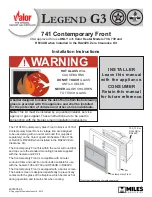
Summary of VOLUME Command Parameters
Input Processing
56
A29247-X4-X-8-7672
Offline mode
For offline operations, the input medium to the printing system is magnetic tape, which may
be recorded in one of a variety of standard vendor formats. As a programmer, you define
the tape input deblocking and record format parameters that reduce physical tape blocks
first to logical records, then to print lines. Special processing commands can also be select-
ed that facilitate report processing by providing for logical functions to be performed on the
input data described later in this chapter.
Before selecting the PDL commands that are to describe a specific job tape, certain tape
structure concepts must be understood. These concepts, discussed in this chapter, enable
the PDL programmer to define job tape characteristics such as host format, block/record
structure, tape translation code, packed data formats, and several other parameters.
Packed data formats
Six-bit characters may be written onto a 9-track tape in a 4-by-3 packed (or compressed)
format. That is, four 6-bit data bytes are compressed into three 8-bit data bytes. Two meth-
ods of packing these bits together exist. One method is used by Honeywell 6000 users
(T4X3), while Honeywell 2000 users employ a slightly different method of packing
(T4X3H2).
Whenever an unpacking method is included in the JDL, the system unpacks the characters
before data processing. Each 6-bit character is extracted, and two high-order zeros are ap-
pended. Normally, after data is unpacked, it must be translated. The character code set is
defined in the CODE parameter of the VOLUME command. For a 4-by-3 unpacking meth-
od, the data is generally encoded in BCD, and one of the three standard BCD CODE pa-
rameters (H2BCD, H6BCD, and IBMBCD) can be used.
Record formats
All tape records input to the printing system are either blocked or unblocked with a fixed
length, a variable length, or an undefined format. The PDL commands BLOCK and
RECORD define the format of the input data. Tape label contents may also describe block-
ing and record structure and in some cases override BLOCK and RECORD commands
specified in the JDL source file.
Record structure
A record is arbitrarily divided into two portions: operating system and user. The operating
system portion of the record contains information supplied by the host operating or spooling
system. The user's portion of the record contains information provided by the application or
user's program running on the host system. The boundary between the two portions of the
record is traditionally between the record length and printer carriage control (PCC) field. If
Summary of Contents for XDL
Page 1: ...Oc Oc Reference Guide Oc PRISMAproduction Server V3 10 LCDS Module XDL DJDE...
Page 4: ...A29247 X4 X 8 7672...
Page 66: ...Summary of VOLUME Command Parameters Input Processing 58 A29247 X4 X 8 7672...
Page 118: ...Summary of OUTPUT Command Parameters Continuation Print Processing 110 A29247 X4 X 8 7672...
Page 120: ...Summary of OUTPUT Command Parameters Continuation Print Processing 112 A29247 X4 X 8 7672...
Page 121: ...Print Processing Summary of OUTPUT Command Parameters Continuation A29247 X4 X 8 7672 113...
Page 123: ...Print Processing Summary of OUTPUT Command Parameters Continuation A29247 X4 X 8 7672 115...
Page 125: ...Print Processing Summary of OUTPUT Command Parameters Continuation A29247 X4 X 8 7672 117...
Page 142: ...Summary of STOCKSET Statement Command Parameters Print Processing 134 A29247 X4 X 8 7672...
Page 176: ...RSUSPEND and RRESUME Commands Using Logical Processing 168 A29247 X4 X 8 7672...
Page 240: ...Migrating to HC Highlight Color Support 232 A29247 X4 X 8 7672...
















































